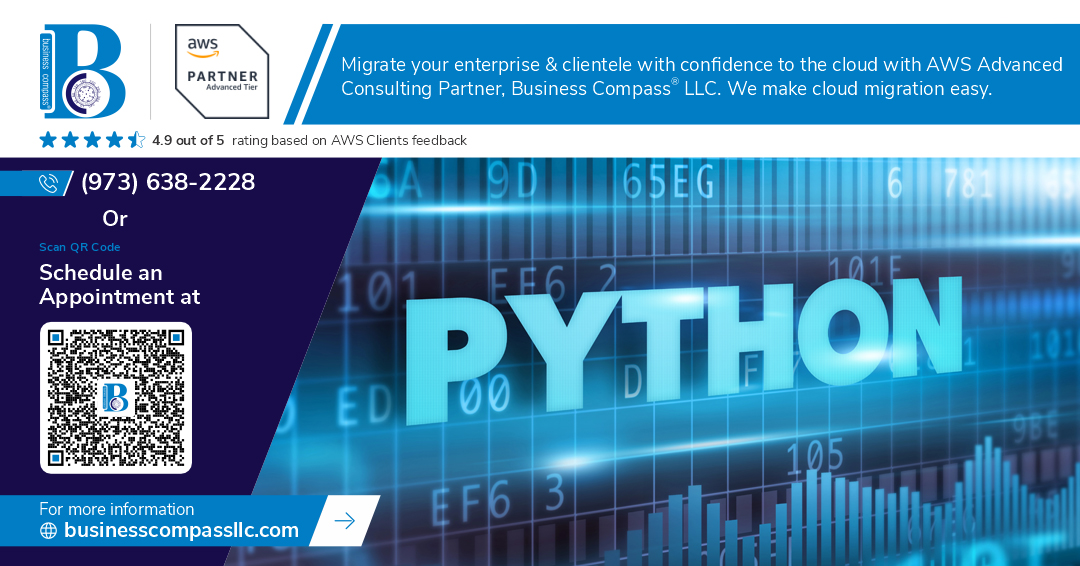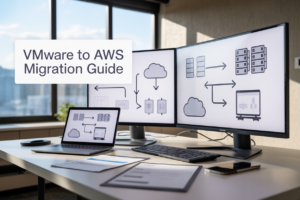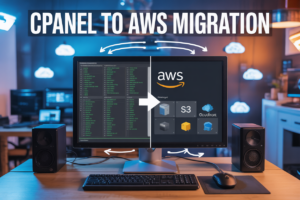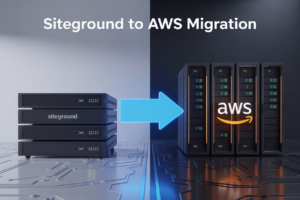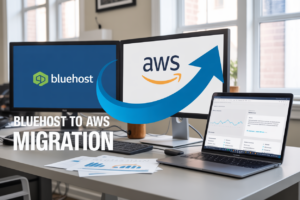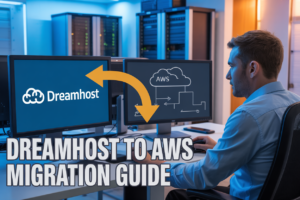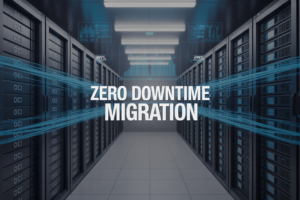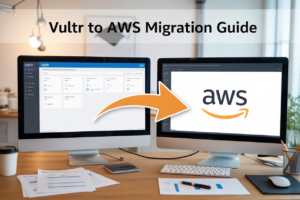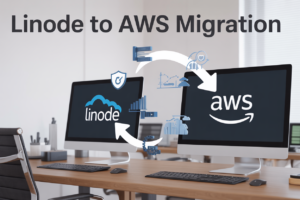AWS infrastructure automation with Python and CloudFormation transforms how you deploy and manage cloud resources. Instead of clicking through the AWS console or running manual commands, you can define your entire infrastructure in code and deploy it consistently across environments.
This comprehensive CloudFormation Python tutorial is designed for DevOps engineers, Python developers, and cloud architects who want to master automated AWS deployment. You’ll learn practical techniques for Infrastructure as Code Python implementation that saves time and reduces errors.
We’ll start with CloudFormation fundamentals and show you how to integrate Python boto3 automation for dynamic resource management. You’ll discover AWS CloudFormation best practices for organizing templates and managing dependencies between resources. The guide also covers essential AWS infrastructure testing strategies to validate your deployments before they reach production.
By the end, you’ll have hands-on experience building automated infrastructure stacks, implementing advanced automation patterns, and scaling your AWS DevOps automation practices. Each section includes real Python AWS SDK tutorial examples you can adapt for your own projects.
Essential Prerequisites for AWS Infrastructure Automation
Setting up your AWS account with proper IAM permissions
Before diving into AWS infrastructure automation with Python, you need to secure your AWS account with appropriate permissions. Create a dedicated IAM user specifically for automation tasks rather than using your root account. Configure this user with programmatic access and attach policies like IAMFullAccess, AmazonEC2FullAccess, and CloudFormationFullAccess. For production environments, follow the principle of least privilege by creating custom policies that grant only necessary permissions for your specific automation needs.
Installing and configuring Python development environment
Your Python development environment forms the foundation for successful CloudFormation automation. Install Python 3.8 or later alongside essential packages like boto3 (the AWS SDK for Python), troposphere for generating CloudFormation templates, and cfn-lint for template validation. Set up a virtual environment to isolate your project dependencies: python -m venv aws-automation && source aws-automation/bin/activate. Install required packages using pip install boto3 troposphere cfn-lint awscli. Consider using pyenv for managing multiple Python versions across different automation projects.
Understanding basic CloudFormation template structure
CloudFormation templates follow a specific JSON or YAML structure that defines your infrastructure as code. Every template contains key sections: AWSTemplateFormatVersion specifies the template format, Description provides template documentation, Parameters allows input customization, Resources defines AWS services to create, and Outputs returns values after stack deployment. Resources represent the core building blocks, each requiring a logical ID, resource type (like AWS::EC2::Instance), and properties. Understanding this structure helps you build maintainable automation scripts that generate valid CloudFormation templates programmatically.
Establishing AWS CLI credentials and regional settings
Proper credential configuration ensures your Python automation scripts can securely interact with AWS services. Run aws configure to set up your access keys, secret keys, default region, and output format. Store sensitive credentials in ~/.aws/credentials and configuration in ~/.aws/config. For enhanced security, use IAM roles when running automation from EC2 instances or consider AWS SSO for temporary credentials. Set your default region strategically based on your infrastructure requirements – this affects resource availability and latency. Test your setup with aws sts get-caller-identity to verify authentication works correctly.
CloudFormation Fundamentals for Python Developers
Mastering template syntax and parameter definitions
CloudFormation templates use JSON or YAML syntax to define AWS resources, with YAML being the preferred choice for Python developers due to its readability. Parameters allow you to customize templates at deployment time, accepting values like instance types, VPC IDs, or environment names. Define parameters with type constraints (String, Number, List) and validation patterns to ensure clean inputs. Resource properties reference parameters using !Ref ParameterName in YAML or {"Ref": "ParameterName"} in JSON, creating flexible and reusable infrastructure templates.
Leveraging intrinsic functions for dynamic resource creation
Intrinsic functions power dynamic CloudFormation templates by manipulating values at stack creation time. !GetAtt retrieves resource attributes like EC2 instance IDs or RDS endpoint URLs. !Sub performs string substitution with variables and pseudo parameters. !Join concatenates arrays into strings for complex naming patterns. !Select extracts specific items from lists. !Ref returns resource IDs or parameter values. Combine these functions to build conditional logic using !If, !Equals, and !Not for environment-specific deployments and sophisticated resource configurations.
Implementing cross-stack references and outputs
Outputs enable cross-stack communication by exporting values from one stack for import by another. Define outputs in the source stack using the Export property with a unique name. Import these values in dependent stacks using !ImportValue. This pattern separates concerns – networking stacks export VPC and subnet IDs while application stacks import them. Cross-stack references create dependencies that CloudFormation tracks, preventing accidental deletion of exported resources. Use descriptive export names with environment prefixes to avoid naming conflicts across multiple deployments.
Understanding stack lifecycle management concepts
Stack lifecycle encompasses creation, updates, and deletion phases that CloudFormation manages automatically. During creation, resources deploy in dependency order with automatic rollback on failures. Updates use change sets to preview modifications before execution, supporting rolling updates for ASG instances and RDS with minimal downtime. Stack policies protect critical resources from accidental updates or deletion. Drift detection identifies manual changes made outside CloudFormation. Stack events provide detailed logs for troubleshooting deployment issues, while stack status indicators show current operational state for effective Infrastructure as Code Python workflows.
Python Libraries and Tools for AWS Automation
Utilizing Boto3 for programmatic AWS service interactions
Boto3 serves as the cornerstone for AWS infrastructure automation with Python, providing comprehensive access to over 200 AWS services through a clean, intuitive API. This powerful Python AWS SDK tutorial demonstrates how developers can programmatically manage EC2 instances, S3 buckets, RDS databases, and Lambda functions with just a few lines of code. The library handles authentication, retries, and pagination automatically, making it perfect for Infrastructure as Code Python implementations. You can create, modify, and delete resources dynamically, query service status, and integrate AWS operations directly into your application logic. Boto3’s resource and client interfaces offer both high-level abstractions and low-level control, giving developers flexibility to choose the right approach for their automated AWS deployment needs.
Implementing Troposphere for Python-based template generation
Troposphere transforms CloudFormation template creation by letting you write infrastructure definitions using native Python code instead of JSON or YAML. This approach brings object-oriented programming benefits to AWS infrastructure automation, including code reuse, validation, and IDE support with auto-completion. The library provides classes for every AWS resource type, complete with parameter validation and type checking that catches errors before deployment. You can create reusable components, implement conditional logic, and generate complex nested templates programmatically. Troposphere integrates seamlessly with version control systems and enables sophisticated CloudFormation Python tutorial patterns like dynamic resource generation based on environment variables or configuration files.
Leveraging AWS CDK as an alternative infrastructure approach
The AWS Cloud Development Kit revolutionizes Infrastructure as Code Python development by combining the expressiveness of programming languages with CloudFormation’s robust deployment engine. CDK constructs represent cloud components at varying levels of abstraction, from low-level CloudFormation resources to high-level patterns that follow AWS best practices. The framework automatically handles resource dependencies, generates CloudFormation templates, and provides built-in security and compliance features. You can share and reuse constructs across projects, implement unit testing for infrastructure code, and leverage familiar programming concepts like inheritance and composition. CDK’s synthesis process converts your Python code into optimized CloudFormation templates, ensuring consistent and reliable AWS DevOps automation workflows while maintaining the flexibility to customize every aspect of your infrastructure.
Building Your First Automated Infrastructure Stack
Creating VPC and networking components programmatically
Building your VPC foundation with Python and CloudFormation starts with defining network architecture through code. Using boto3 and CloudFormation templates, you can programmatically create isolated virtual networks, configure subnets across multiple availability zones, and establish internet gateways for public access. This approach enables consistent network deployment patterns while maintaining version control over your Infrastructure as Code Python implementations.
import boto3
import json
def create_vpc_template():
template = {
"AWSTemplateFormatVersion": "2010-09-09",
"Resources": {
"MyVPC": {
"Type": "AWS::EC2::VPC",
"Properties": {
"CidrBlock": "10.0.0.0/16",
"EnableDnsHostnames": True,
"EnableDnsSupport": True
}
},
"PublicSubnet": {
"Type": "AWS::EC2::Subnet",
"Properties": {
"VpcId": {"Ref": "MyVPC"},
"CidrBlock": "10.0.1.0/24",
"AvailabilityZone": {"Fn::Select": [0, {"Fn::GetAZs": ""}]},
"MapPublicIpOnLaunch": True
}
},
"InternetGateway": {
"Type": "AWS::EC2::InternetGateway"
},
"AttachGateway": {
"Type": "AWS::EC2::VPCGatewayAttachment",
"Properties": {
"VpcId": {"Ref": "MyVPC"},
"InternetGatewayId": {"Ref": "InternetGateway"}
}
}
}
}
return json.dumps(template, indent=2)
# Deploy the stack
client = boto3.client('cloudformation')
response = client.create_stack(
StackName='vpc-infrastructure',
TemplateBody=create_vpc_template()
)
Route tables and network ACLs complete your networking foundation. Create route tables that direct traffic between subnets and the internet gateway, while network ACLs provide subnet-level security. This programmatic approach to AWS infrastructure automation with Python ensures repeatable deployments across development, staging, and production environments.
| Component | Purpose | CIDR Example |
|---|---|---|
| VPC | Isolated network environment | 10.0.0.0/16 |
| Public Subnet | Internet-accessible resources | 10.0.1.0/24 |
| Private Subnet | Internal resources only | 10.0.2.0/24 |
| NAT Gateway | Outbound internet for private resources | N/A |
Deploying EC2 instances with automated configuration
EC2 instance deployment through CloudFormation Python automation streamlines server provisioning with consistent configurations. Your CloudFormation templates define instance types, AMIs, key pairs, and user data scripts that automatically configure applications upon launch. This automated AWS deployment approach eliminates manual server setup while ensuring identical environments across your infrastructure.
def create_ec2_template():
return {
"AWSTemplateFormatVersion": "2010-09-09",
"Parameters": {
"InstanceType": {
"Type": "String",
"Default": "t3.micro",
"AllowedValues": ["t3.micro", "t3.small", "t3.medium"]
},
"KeyName": {
"Type": "AWS::EC2::KeyPair::KeyName",
"Description": "EC2 Key Pair for SSH access"
}
},
"Resources": {
"WebServer": {
"Type": "AWS::EC2::Instance",
"Properties": {
"InstanceType": {"Ref": "InstanceType"},
"ImageId": "ami-0abcdef1234567890",
"KeyName": {"Ref": "KeyName"},
"SubnetId": {"Ref": "PublicSubnet"},
"SecurityGroupIds": [UserData": {
"Fn::Base64": {
"Fn::Join": ["", [
"#!/bin/bash\n",
"yum update -y\n",
"yum install -y httpd\n",
"systemctl start httpd\n",
"systemctl enable httpd\n",
"echo '<h1>Automated Web Server</h1>' > /var/www/html/index.html\n"
]]
}
}
}
}
}
}
User data scripts handle initial server configuration, installing packages, starting services, and configuring applications. CloudFormation waits for instance initialization signals, ensuring your automation pipeline knows when resources are ready. Launch templates provide additional flexibility for instance configuration management, supporting versioning and parameter overrides for different deployment scenarios.
Advanced instance configurations include IAM roles for AWS service access, detailed monitoring, and placement groups for performance optimization. Your Python automation scripts can dynamically generate these configurations based on environment requirements, creating a flexible Infrastructure as Code Python solution that adapts to changing needs while maintaining security and performance standards.
Setting up security groups and access controls
Security groups act as virtual firewalls controlling traffic to your AWS resources. CloudFormation Python automation enables you to define granular ingress and egress rules programmatically, ensuring consistent security policies across all environments. Your security group configurations should follow least privilege principles, opening only required ports and protocols for specific IP ranges or other security groups.
def create_security_groups():
return {
"WebServerSecurityGroup": {
"Type": "AWS::EC2::SecurityGroup",
"Properties": {
"GroupDescription": "Security group for web servers",
"VpcId": {"Ref": "MyVPC"},
"SecurityGroupIngress": [
{
"IpProtocol": "tcp",
"FromPort": 80,
"ToPort": 80,
"CidrIp": "0.0.0.0/0"
},
{
"IpProtocol": "tcp",
"FromPort": 443,
"ToPort": 443,
"CidrIp": "0.0.0.0/0"
},
{
"IpProtocol": "tcp",
"FromPort": 22,
"ToPort": 22,
"CidrIp": "10.0.0.0/8"
}
],
"SecurityGroupEgress": [
{
"IpProtocol": "-1",
"CidrIp": "0.0.0.0/0"
}
]
}
},
"DatabaseSecurityGroup": {
"Type": "AWS::EC2::SecurityGroup",
"Properties": {
"GroupDescription": "Security group for database servers",
"VpcId": {"Ref": "MyVPC"},
"SecurityGroupIngress": [
{
"IpProtocol": "tcp",
"FromPort": 3306,
"ToPort": 3306,
"SourceSecurityGroupId": {"Ref": "WebServerSecurityGroup"}
}
]
}
}
}
IAM roles and policies complement security groups by controlling AWS service access. Your automated AWS deployment should include service-linked roles for EC2 instances, enabling them to interact with other AWS services without hardcoded credentials. Python boto3 automation can create and attach policies dynamically based on application requirements.
| Security Layer | Purpose | Implementation |
|---|---|---|
| Security Groups | Network-level access control | Port and protocol restrictions |
| IAM Roles | Service-level permissions | AWS API access control |
| Network ACLs | Subnet-level filtering | Additional network security |
| Resource Policies | Resource-specific access | S3, Lambda, and other services |
Cross-referencing security groups creates layered security architectures where database security groups only accept connections from web server security groups. This pattern eliminates the need for hardcoded IP addresses while maintaining strict access controls that automatically adapt when resources scale or change.
Implementing load balancers and auto-scaling groups
Application Load Balancers distribute incoming traffic across multiple EC2 instances, providing high availability and fault tolerance. Your CloudFormation Python tutorial implementation creates target groups, health checks, and listener rules that automatically route requests to healthy instances. This automated AWS deployment pattern ensures your applications remain available during instance failures or maintenance windows.
def create_load_balancer_config():
return {
"ApplicationLoadBalancer": {
"Type": "AWS::ElasticLoadBalancingV2::LoadBalancer",
"Properties": {
"Name": "web-app-alb",
"Scheme": "internet-facing",
"Type": "application",
"Subnets": [
{"Ref": "PublicSubnet1"},
{"Ref": "PublicSubnet2"}
],
"SecurityGroups": [{"Ref": "ALBSecurityGroup"}]
}
},
"TargetGroup": {
"Type": "AWS::ElasticLoadBalancingV2::TargetGroup",
"Properties": {
"Name": "web-servers",
"Port": 80,
"Protocol": "HTTP",
"VpcId": {"Ref": "MyVPC"},
"HealthCheckPath": "/health",
"HealthCheckIntervalSeconds": 30,
"HealthyThresholdCount": 2,
"UnhealthyThresholdCount": 3
}
},
"LoadBalancerListener": {
"Type": "AWS::ElasticLoadBalancingV2::Listener",
"Properties": {
"DefaultActions": [
{
"Type": "forward",
"TargetGroupArn": {"Ref": "TargetGroup"}
}
],
"LoadBalancerArn": {"Ref": "ApplicationLoadBalancer"},
"Port": 80,
"Protocol": "HTTP"
}
}
}
Auto Scaling Groups automatically adjust instance capacity based on demand, cost optimization, or health metrics. Your Infrastructure as Code Python implementation defines scaling policies that respond to CloudWatch alarms, ensuring optimal resource utilization. Launch templates specify instance configurations while scaling policies determine when and how many instances to add or remove.
def create_autoscaling_config():
return {
"LaunchTemplate": {
"Type": "AWS::EC2::LaunchTemplate",
"Properties": {
"LaunchTemplateName": "web-server-template",
"LaunchTemplateData": {
"InstanceType": "t3.micro",
"ImageId": "ami-0abcdef1234567890",
"SecurityGroupIds": [{"Ref": "WebServerSecurityGroup"}],
"IamInstanceProfile": {"Arn": {"Fn::GetAtt": ["InstanceProfile", "Arn"]}},
"UserData": {"Fn::Base64": "#!/bin/bash\nyum update -y\n"}
}
}
},
"AutoScalingGroup": {
"Type": "AWS::AutoScaling::AutoScalingGroup",
"Properties": {
"AutoScalingGroupName": "web-server-asg",
"LaunchTemplate": {
"LaunchTemplateId": {"Ref": "LaunchTemplate"},
"Version": {"Fn::GetAtt": ["LaunchTemplate", "LatestVersionNumber"]}
},
"MinSize": "2",
"MaxSize": "10",
"DesiredCapacity": "3",
"VPCZoneIdentifier": [
{"Ref": "PrivateSubnet1"},
{"Ref": "PrivateSubnet2"}
],
"TargetGroupARNs": [{"Ref": "TargetGroup"}],
"HealthCheckType": "ELB",
"HealthCheckGracePeriod": 300
}
}
}
Scaling policies respond to metrics like CPU utilization, request count, or custom CloudWatch metrics. Your AWS CloudFormation best practices should include predictive scaling for anticipated load patterns and step scaling for gradual capacity adjustments. Python automation scripts can modify scaling parameters based on time of day, seasonal patterns, or application-specific requirements.
| Scaling Type | Use Case | Response Time |
|---|---|---|
| Target Tracking | Maintain specific metric target | 1-3 minutes |
| Step Scaling | Gradual capacity adjustments | 1-5 minutes |
| Scheduled Scaling | Predictable load patterns | Immediate |
| Predictive Scaling | Machine learning-based forecasting | 15 minutes ahead |
Health checks ensure load balancers only route traffic to healthy instances while auto scaling groups replace failed instances automatically. Your automated infrastructure maintains application availability without manual intervention, creating resilient systems that handle traffic spikes and component failures gracefully through intelligent automation patterns.
Advanced Automation Patterns and Best Practices
Implementing parameterized templates for environment flexibility
Parameterized CloudFormation templates transform your AWS infrastructure automation with Python into a flexible, reusable system. Use parameters to define environment-specific values like instance types, VPC CIDRs, and database configurations, allowing the same template to deploy across development, staging, and production environments. Python scripts can dynamically populate these parameters through boto3’s CloudFormation client, reading values from configuration files, environment variables, or external systems like AWS Parameter Store. This approach eliminates hardcoded values and enables easy environment promotion while maintaining Infrastructure as Code principles.
parameters = {
'EnvironmentType': 'production',
'InstanceType': 't3.large' if env == 'prod' else 't3.micro',
'DatabaseStorage': '100' if env == 'prod' else '20'
}
cloudformation.create_stack(
StackName=f'myapp-{env}',
TemplateBody=template,
Parameters=[, 'ParameterValue': v} for k, v in parameters.items()]
)
Creating reusable infrastructure modules and components
Building reusable CloudFormation modules accelerates AWS infrastructure automation with Python development and ensures consistency across projects. Create nested stacks for common components like VPCs, security groups, and load balancers, then reference them from master templates. Python automation scripts can deploy these modular stacks independently or as dependencies, managing the entire infrastructure lifecycle. Store templates in S3 buckets or version control systems, allowing teams to share and version infrastructure components. This modular approach reduces duplication, improves maintainability, and establishes infrastructure standards across your organization.
| Module Type | Purpose | Reuse Scenarios |
|---|---|---|
| VPC Module | Network foundation | Multi-environment deployments |
| Database Module | RDS configurations | Application stacks |
| Security Module | IAM roles and policies | Cross-project compliance |
Managing secrets and sensitive data securely
Secure secret management is critical when building automated AWS deployment systems with Python. Never embed sensitive data directly in CloudFormation templates or Python scripts. Instead, use AWS Systems Manager Parameter Store or AWS Secrets Manager to store database passwords, API keys, and certificates. Reference these secrets in templates using dynamic references like {{resolve:secretsmanager:prod/db/password}}. Python automation scripts can retrieve secrets at runtime using boto3, ensuring credentials never appear in logs or version control. Implement proper IAM permissions to restrict secret access and enable automatic rotation where possible.
import boto3
secrets_client = boto3.client('secretsmanager')
db_password = secrets_client.get_secret_value(
SecretId='prod/database/password'
)['SecretString']
# Use password in CloudFormation parameter
parameters.append({
'ParameterKey': 'DatabasePassword',
'ParameterValue': db_password
})
Establishing proper error handling and rollback strategies
Robust error handling transforms unreliable automation into production-ready AWS infrastructure automation with Python. Implement comprehensive exception handling in your Python scripts to catch CloudFormation failures, timeout errors, and resource conflicts. Use waiter functions to monitor stack operations and set appropriate timeout values. Design rollback strategies that preserve data and maintain service availability during failed deployments. CloudFormation’s automatic rollback feature works well for simple cases, but complex scenarios require custom rollback logic in your Python automation code. Log all operations and maintain audit trails for troubleshooting and compliance requirements.
try:
waiter = cloudformation.get_waiter('stack_create_complete')
waiter.wait(StackName=stack_name, WaiterConfig={'Delay': 30, 'MaxAttempts': 60})
except WaiterError as e:
print(f"Stack creation failed: {e}")
# Implement custom rollback logic
rollback_infrastructure(stack_name)
raise
Testing and Validation Strategies
Implementing pre-deployment template validation checks
Catching CloudFormation template errors before deployment saves hours of debugging and prevents costly infrastructure failures. Use cfn-lint to validate template syntax, resource properties, and AWS service limits, while cfn_nag identifies security vulnerabilities like overly permissive IAM policies or unencrypted resources. Python’s boto3 client offers programmatic validation through validate_template() API calls, enabling automated checks in your CI/CD pipeline. Create custom validation scripts that verify parameter constraints, check cross-stack dependencies, and ensure naming conventions align with organizational standards. These pre-flight checks catch configuration drift, missing dependencies, and policy violations before they impact production environments.
Creating automated testing pipelines for infrastructure code
Automated testing pipelines transform Infrastructure as Code into reliable, repeatable deployments. Set up GitHub Actions or Jenkins pipelines that trigger on code commits, running template validation, security scans, and deployment tests across multiple AWS environments. Use pytest with moto library to mock AWS services for unit testing your Python automation scripts without incurring cloud costs. Implement integration tests by deploying stacks to dedicated testing accounts, verifying resource creation, and cleaning up automatically. Tools like TaskCat enable multi-region testing of CloudFormation templates, while Terratest provides Go-based testing frameworks for infrastructure validation. Include rollback testing to ensure your disaster recovery procedures work correctly.
Monitoring stack deployments and performance metrics
Real-time monitoring transforms infrastructure automation from deployment-and-hope to data-driven operations. CloudWatch provides stack-level metrics through CloudFormation events, tracking deployment duration, failure rates, and resource creation times across your automation pipeline. Set up CloudWatch alarms for stack operations, triggering SNS notifications when deployments fail or exceed expected timeframes. Python scripts can poll stack status using boto3.describe_stacks() and describe_stack_events(), creating custom dashboards that visualize deployment health across multiple environments. Implement drift detection monitoring to catch manual changes that diverge from your Infrastructure as Code definitions. Use AWS Config rules to continuously validate resource compliance with organizational policies and security standards.
Scaling and Managing Production Infrastructure
Implementing blue-green deployment strategies
Blue-green deployments eliminate downtime by maintaining two identical production environments. Python scripts can orchestrate CloudFormation stack updates, switching traffic between environments using Application Load Balancers. The boto3 SDK enables automated health checks and rollback mechanisms. Create separate CloudFormation templates for each environment, deploy updates to the inactive environment, validate functionality, then route traffic seamlessly. This AWS infrastructure automation approach reduces deployment risks while maintaining continuous availability for critical applications.
Setting up automated backup and disaster recovery
Automated backup strategies protect production infrastructure through scheduled snapshots and cross-region replication. Python automation scripts leverage boto3 to create EBS snapshots, RDS backups, and S3 cross-region replication policies. CloudFormation templates define backup retention policies and recovery time objectives. Lambda functions triggered by CloudWatch Events can automate disaster recovery procedures, including infrastructure recreation in alternate regions. AWS infrastructure automation ensures business continuity through programmatic backup validation and automated recovery testing procedures.
Establishing cost optimization and resource monitoring
Cost optimization requires continuous monitoring of AWS resources through automated analysis and rightsizing recommendations. Python scripts using boto3 can analyze CloudWatch metrics to identify underutilized resources and suggest optimizations. CloudFormation stack management includes implementing auto-scaling policies and scheduled resource termination. Cost Explorer API integration enables automated budget alerts and spending analysis. AWS DevOps automation tools track resource utilization patterns, automatically resize instances based on demand, and generate cost optimization reports for production environments.
Creating infrastructure documentation and change management processes
Infrastructure documentation automation generates current system configurations directly from deployed CloudFormation stacks. Python scripts extract stack parameters, resource configurations, and dependency relationships to create living documentation. Version control integration tracks infrastructure changes through automated commit messages and pull request templates. Change management processes include automated approval workflows, rollback procedures, and deployment notifications. CloudFormation stack management tools maintain infrastructure change logs, enabling audit trails and compliance reporting for production systems.
Automating your AWS infrastructure with Python and CloudFormation transforms how you manage cloud resources. You’ve learned the essential building blocks – from setting up the right prerequisites to mastering CloudFormation basics, leveraging powerful Python libraries, and creating your first automated stack. The advanced patterns, testing strategies, and production scaling techniques covered here give you a solid foundation to build reliable, maintainable infrastructure.
Ready to put these skills into practice? Start small with a simple stack deployment and gradually work your way up to more complex automation patterns. The combination of Python’s flexibility and CloudFormation’s declarative approach opens up endless possibilities for streamlining your infrastructure management. Your future self will thank you for investing the time to automate these processes now.










